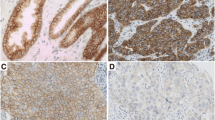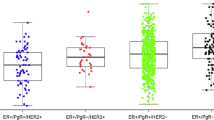Abstract
The growth factor receptor-bound protein-7 gene (GRB7) encodes a multi-domain signal transduction molecule. The purpose of this study was to examine the clinical significance of GRB7 protein expression in human breast cancer. Western blotting analysis of protein extracts from 563 annotated frozen breast tumors was performed. Expression status of GRB7 and HER-2 was correlated with clinical covariates and outcomes. Cox proportional hazards were used to identify factors associated with breast cancer-free interval. The median follow-up was 71 months. P values <0.05 were considered statistically significant (two-sided). A discrepancy between HER-2 and GRB7 protein over-expression was observed. GRB7 protein over-expression was associated with negative estrogen and progesterone receptor status, higher tumor grade, larger primary tumor size, (more) axillary lymph node involvement, higher clinical stage, and shortened breast cancer-free interval. HER-2 protein over-expression was associated only with higher tumor grade. Multi-variate analysis revealed that GRB7 protein over-expression was an independent adverse prognostic factor for breast cancer-free interval (hazard ratio 1.69, 95% confidence interval 1.07–2.67; P = 0.024). The same was true of the subset of patients who did not receive any adjuvant systemic therapy (hazard ratio 1.68, 95% confidence interval 1.16–2.31; P = 0.0055). Using FISH analysis, 32/32 (100%; 95% CI 89–100%) tumors which over-expressed both HER-2 and GRB7 proteins and 1/35 (3%; 95% CI 0–15%) tumors with HER-2 but no GRB7 protein over-expression with Western blotting analysis demonstrated HER-2 gene amplification. GRB7 protein over-expression is an independent adverse prognostic factor in human breast cancer.



Similar content being viewed by others
References
Slamon DJ, Clark GM, Wong SG, Levin WJ, Ullrich A, McGuire WL (1987) Human breast cancer: correlation of relapse and survival with amplification of the HER-2/neu oncogene. Science 235(4785):177–182
Slamon DJ, Godolphin W, Jones LA, Holt JA, Wong SG, Keith DE, Levin WJ, Stuart SG, Udove J, Ullrich A et al (1989) Studies of the HER-2/neu proto-oncogene in human breast and ovarian cancer. Science 244(4905):707–712
Chia S, Norris B, Speers C, Cheang M, Gilks B, Gown AM, Huntsman D, Olivotto IA, Nielsen TO, Gelmon K (2008) Human epidermal growth factor receptor 2 overexpression as a prognostic factor in a large tissue microarray series of node-negative breast cancers. J Clin Oncol 26(35):5697–5704
Harris L, Fritsche H, Mennel R, Norton L, Ravdin P, Taube S, Somerfield MR, Hayes DF, Bast RC Jr (2007) American Society of Clinical Oncology 2007 update of recommendations for the use of tumor markers in breast cancer. J Clin Oncol 25(33):5287–5312
Slamon DJ, Leyland-Jones B, Shak S, Fuchs H, Paton V, Bajamonde A, Fleming T, Eiermann W, Wolter J, Pegram M et al (2001) Use of chemotherapy plus a monoclonal antibody against HER2 for metastatic breast cancer that overexpresses HER2. N Engl J Med 344(11):783–792
Geyer CE, Forster J, Lindquist D, Chan S, Romieu CG, Pienkowski T, Jagiello-Gruszfeld A, Crown J, Chan A, Kaufman B et al (2006) Lapatinib plus capecitabine for HER2-positive advanced breast cancer. N Engl J Med 355(26):2733–2743
Wolff AC, Hammond ME, Schwartz JN, Hagerty KL, Allred DC, Cote RJ, Dowsett M, Fitzgibbons PL, Hanna WM, Langer A et al (2007) American Society of Clinical Oncology/College of American Pathologists guideline recommendations for human epidermal growth factor receptor 2 testing in breast cancer. Arch Pathol Lab Med 131(1):18
Sauter G, Lee J, Bartlett JM, Slamon DJ, Press MF (2009) Guidelines for human epidermal growth factor receptor 2 testing: biologic and methodologic considerations. J Clin Oncol 27(8):1323–1333
Kauraniemi P, Barlund M, Monni O, Kallioniemi A (2001) New amplified and highly expressed genes discovered in the ERBB2 amplicon in breast cancer by cDNA microarrays. Cancer Res 61(22):8235–8240
Kauraniemi P, Kallioniemi A (2006) Activation of multiple cancer-associated genes at the ERBB2 amplicon in breast cancer. Endocr Relat Cancer 13(1):39–49
Stein D, Wu J, Fuqua SA, Roonprapunt C, Yajnik V, D’Eustachio P, Moskow JJ, Buchberg AM, Osborne CK, Margolis B (1994) The SH2 domain protein GRB-7 is co-amplified, overexpressed and in a tight complex with HER2 in breast cancer. EMBO J 13(6):1331–1340
Kauraniemi P, Kuukasjarvi T, Sauter G, Kallioniemi A (2003) Amplification of a 280-kilobase core region at the ERBB2 locus leads to activation of two hypothetical proteins in breast cancer. Am J Pathol 163(5):1979–1984
Marchio C, Natrajan R, Shiu KK, Lambros MB, Rodriguez-Pinilla SM, Tan DS, Lord CJ, Hungermann D, Fenwick K, Tamber N et al (2008) The genomic profile of HER2-amplified breast cancers: the influence of ER status. J Pathol 216(4):399–407
Luoh SW (2002) Amplification and expression of genes from the 17q11–q12 amplicon in breast cancer cells. Cancer Genet Cytogenet 136(1):43–47
Esteva FJ, Sahin AA, Cristofanilli M, Coombes K, Lee SJ, Baker J, Cronin M, Walker M, Watson D, Shak S et al (2005) Prognostic role of a multigene reverse transcriptase-PCR assay in patients with node-negative breast cancer not receiving adjuvant systemic therapy. Clin Cancer Res 11(9):3315–3319
Shen TL, Guan JL (2004) Grb7 in intracellular signaling and its role in cell regulation. Front Biosci 9:192–200
Chu PY, Huang LY, Hsu CH, Liang CC, Guan JL, Hung TH, Shen TL (2009) Tyrosine phosphorylation of growth factor receptor-bound protein-7 by focal adhesion kinase in the regulation of cell migration, proliferation, and tumorigenesis. J Biol Chem 284(30):20215–20226
Tsai NP, Lin YL, Tsui YC, Wei LN (2010) Dual action of epidermal growth factor: extracellular signal-stimulated nuclear-cytoplasmic export and coordinated translation of selected messenger RNA. J Cell Biol 188(3):325–333
Tsai NP, Tsui YC, Pintar JE, Loh HH, Wei LN (2010) Kappa opioid receptor contributes to EGF-stimulated neurite extension in development. Proc Natl Acad Sci USA 107(7):3216–3221
Skotheim RI, Monni O, Mousses S, Fossa SD, Kallioniemi OP, Lothe RA, Kallioniemi A (2002) New insights into testicular germ cell tumorigenesis from gene expression profiling. Cancer Res 62(8):2359–2364
Bai T, Luoh SW (2008) GRB-7 facilitates HER-2/Neu-mediated signal transduction and tumor formation. Carcinogenesis 29(3):473–479
Christianson TA, Doherty JK, Lin YJ, Ramsey EE, Holmes R, Keenan EJ, Clinton GM (1998) NH2-terminally truncated HER-2/neu protein: relationship with shedding of the extracellular domain and with prognostic factors in breast cancer. Cancer Res 58(22):5123–5129
Saez R, Molina MA, Ramsey EE, Rojo F, Keenan EJ, Albanell J, Lluch A, Garcia-Conde J, Baselga J, Clinton GM (2006) p95HER-2 predicts worse outcome in patients with HER-2-positive breast cancer. Clin Cancer Res 12(2):424–431
Hudis CA, Barlow WE, Costantino JP, Gray RJ, Pritchard KI, Chapman JA, Sparano JA, Hunsberger S, Enos RA, Gelber RD et al (2007) Proposal for standardized definitions for efficacy end points in adjuvant breast cancer trials: the STEEP system. J Clin Oncol 25(15):2127–2132
van Agthoven T, Sieuwerts AM, Meijer-van Gelder ME, Look MP, Smid M, Veldscholte J, Sleijfer S, Foekens JA, Dorssers LC (2009) Relevance of breast cancer antiestrogen resistance genes in human breast cancer progression and tamoxifen resistance. J Clin Oncol 27(4):542–549
Perou CM, Sorlie T, Eisen MB, van de Rijn M, Jeffrey SS, Rees CA, Pollack JR, Ross DT, Johnsen H, Akslen LA et al (2000) Molecular portraits of human breast tumours. Nature 406(6797):747–752
Tandon AK, Clark GM, Chamness GC, Ullrich A, McGuire WL (1989) HER-2/neu oncogene protein and prognosis in breast cancer. J Clin Oncol 7(8):1120–1128
Kallioniemi OP, Kallioniemi A, Kurisu W, Thor A, Chen LC, Smith HS, Waldman FM, Pinkel D, Gray JW (1992) ERBB2 amplification in breast cancer analyzed by fluorescence in situ hybridization. Proc Natl Acad Sci USA 89(12):5321–5325
Pauletti G, Dandekar S, Rong H, Ramos L, Peng H, Seshadri R, Slamon DJ (2000) Assessment of methods for tissue-based detection of the HER-2/neu alteration in human breast cancer: a direct comparison of fluorescence in situ hybridization and immunohistochemistry. J Clin Oncol 18(21):3651–3664
Persons DL, Borelli KA, Hsu PH (1997) Quantitation of HER-2/neu and c-myc gene amplification in breast carcinoma using fluorescence in situ hybridization. Mod Pathol 10(7):720–727
Nadler Y, Gonzalez AM, Camp RL, Rimm DL, Kluger HM, Kluger Y (2010) Growth factor receptor-bound protein-7 (Grb7) as a prognostic marker and therapeutic target in breast cancer. Ann Oncol 21(3):466–473
Acknowledgments
The work is supported by Department of Veterans Affairs, Portland VA Research Foundation, OHSU Presidential Bridge Award, and OHSU Foundation. We are grateful to the technical assistance provided by the Histology Shared Resources at the Knight Cancer Institute, OHSU.
Author information
Authors and Affiliations
Corresponding author
Rights and permissions
About this article
Cite this article
Ramsey, B., Bai, T., Hanlon Newell, A. et al. GRB7 protein over-expression and clinical outcome in breast cancer. Breast Cancer Res Treat 127, 659–669 (2011). https://doi.org/10.1007/s10549-010-1010-0
Received:
Accepted:
Published:
Issue Date:
DOI: https://doi.org/10.1007/s10549-010-1010-0




